More sales with the same amount of money? Yes, please!
How do you do it? By optimizing your online store and the campaigns that you run. Use our free checklist (download it above) as a workbook to guide you through the process and help you prioritize.
Now, let us give you a glimpse of the contents of our eCommerce CRO checklist, and what you can use it for:
1. Growing Your Traffic
Let’s start with growing your traffic. More (good) traffic on your website = more sales. Driving more traffic usually starts with creating a marketing strategy for eCommerce. Here are some ideas from the checklist that you can use to grow your traffic.
- Give a try to optimizing your website for search engines. Here’s an article about relevant SEO metrics for eCommerce websites.
- Optimize your Google Ads campaigns with Mouseflow – and get a higher bang for your buck.
- Consider expanding your presence to TikTok. With more than 1.2 billion users (according to Statista), TikTok is one of the biggest social media platforms.
- Are you already using Instagram for paid social ads? If your products are visually appealing, Instagram is the place to advertise them!
- Are you working with micro-influencers (under 100,000 followers)? They have a more engaged following and better targeted niches than the ones with a bigger audience.
And there are 22 more hacks for traffic growth in the checklist. Give it a try!
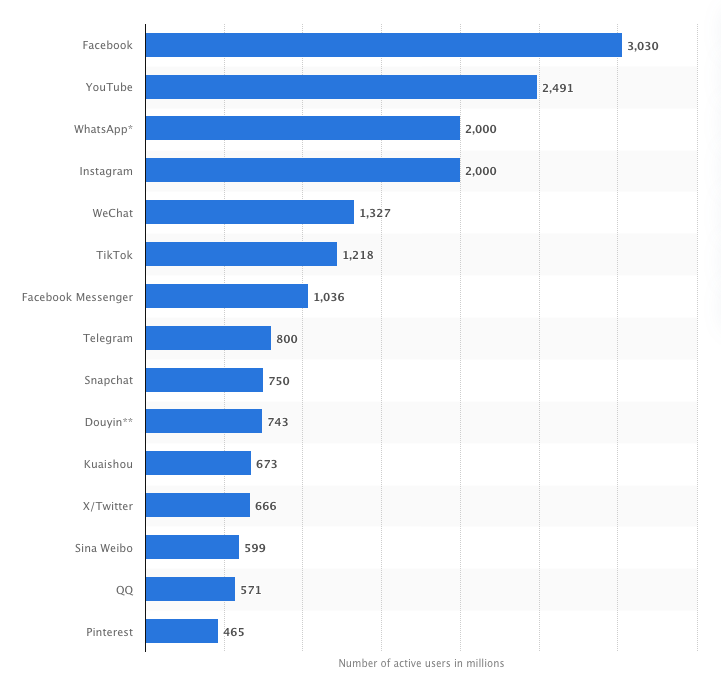
All these social networks could be a traffic source for your ecommerce website. Choose wisely! Source: Statista
2. Reducing Bounce Rates
In eCommerce digital marketing, a bounce is when a user comes to your store and leaves without any action. It means that you’ve wasted a little bit of your ad budget. What can you do to lower the bounce rate?
- Improve website performance: Enhance website speed by optimizing images and using a content delivery network (CDN).
- Automate alerts and monitoring for your website’s page speeds. For example, Pagevitals help you with that, as well as give you an idea about what takes the longest to load.
- Add verified opinions, text or video testimonials to your store. People tend to stay longer on pages that provide trust signals.
And there’re 22 more website tweaks to reduce bounce rates in our free eCommerce optimization checklist. Try them out!
Download the full checklist
3. Improving Searchability
Once you get prospects to visit your website and pay some attention, the next step is to make sure they can find what they’re looking for. While some go to category pages, many use your website’s search feature. According to Forrester Research, visitors who do so are 2-3 times more likely to buy. So, make it a pleasant experience for them (and drive more revenue)!
What can you do? For example:
- Use your website’s search engine to promote products. If there’s a related product featured in the search results, visitors may pay some attention to it. Products with discounts are likely to get more attention.
- Showcase most popular filters. Filtering helps users get to what they want, and highlighting the most popular filters simplifies that process. Also, make sure you allow multiple filters at once.
- Allow different sorting methods. Some users want the cheapest first, some are looking for new products. Make sure that you offer different sorting options to cater to different shopper types.
There are 36 more hacks for improving searchability of your eCommerce website in our checklist. Every single one comes with an example. Download it now!
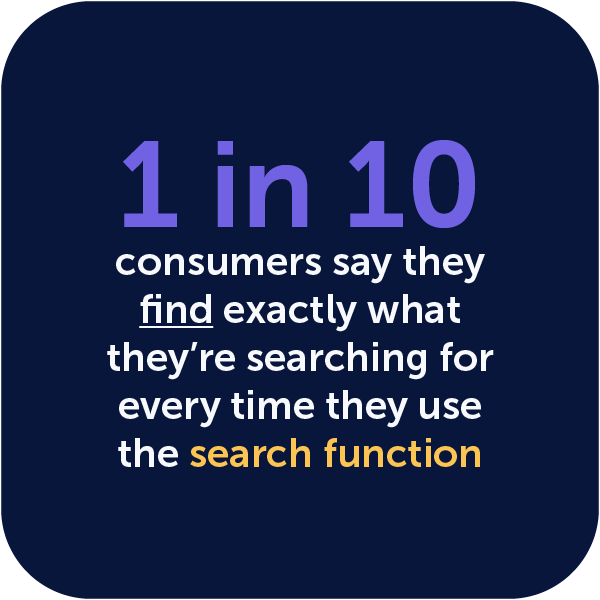
Data source: Google Cloud For Retail
4. Improving Product Pages
Once a website visitor gets to the product page, this is where they decide whether they want to buy a certain thing. By making your product look good and helping your website visitors find out everything they want about the product, you can increase the conversion rate from visiting a product page to adding a product to cart.
Here’s how you do it:
- Write effective product descriptions. Effective means that they are clear, descriptive, written in the same language and tone of voice that your target audience uses, and optimized for search engines.
- Provide high-quality photos. According to Insider Intelligence, 83% of U.S. smartphone users found product images to be very or extremely influential. So, ensure that you have enough product photos and show the product from different sides. Maybe even offer a video (it influenced only 36%, though still a significant number).
- Recommend alternative products. If, upon examining the product description or photos, the website visitor decides that this particular product is not suitable for them, displaying alternatives can help you retain the visitor on your website.
There are 6 more ideas on improving product pages in the optimization checklist. Check them out!
5. Improving Category Pages
Category pages are one of the three most important ways users discover your products. They should be easy to navigate, clear, and provide the right information. That’ll help the users proceed to the next stage – the product page (or even checkout right away).
So, what can you do on the category pages to make them more functional and better at converting?
- Add urgency to your items by indicating if it is in limited stock and selling out fast. Despite being an old and well known trick, urgency still works as an incentive to buy now rather than delay the purchase.
- Make more details about the product appear on mouse hover. It could be a product description, more product photos, or both. Offering a user the information right away helps them make decisions. And that, in turn, increases the chances they’ll proceed to purchasing something.
- Direct attention toward bestsellers. You can add a “bestseller” badge or use a different frame to highlight them. We’ll touch on this point again later, in the “increasing margins” section.
There are 8 more tips to optimize category pages together with another 8 for improving product previews in the checklist.

Source: Shein
6. Enhancing Checkout Experience
Losing potential customers at checkout is especially frustrating – they almost made a purchase, but something in the process made them change their mind. This is why the checkout process has to be as smooth as possible. One of the things that Sensorem used to double their conversion rate was checkout optimization.
How do you smoothen it?
- Provide multiple relevant payment options. The more – the better. Make sure to include locally relevant payment options, as well as provide an option to pay in installments.
- Reduce the number of checkout steps. According to Baymard Institute, 22% (as of 2024) of shoppers abandon checkouts because the process was too long. So, maybe it’s worth even trying the one step checkout option. However, be mindful that it may not work as well on mobile devices due to the length of the page.
- Offer guest checkout. Another 26%, according to the same Baymard Institue’s research, abandon the cart because the site required them to create an account. Don’t want to lose a quarter of your potential customers? Offer them the option to check out their carts without creating an account.
There are many things you can do about checkout. In addition to these 3 tips, we have 21 other experiment ideas available in the checklist. Take a look!
7. Get The Customers Back to Finish Purchase
As per Baymard Institute’s study, the average documented rate of shopping cart abandonment is 70.19%. That means that every 7 in 10 website visitors that added something to cart didn’t proceed to make a purchase. What if you could get some of those visitors back?
While some of them still might not be ready to buy, some just forgot about their carts and would be happy to complete the process.
Here are some of the things that you can do for your potential customer to come back:
- Launch retargeting campaigns using display advertising networks. Display is the perfect way to bring the product visuals back in front of the buyer’s eyes. They may remember that they wanted the goods, and return to your site to complete the purchase. Andrew Lolk, founder of SavvyRevenue agency, recommends retargeting people who visited your website during the last 60 days.
- Automate purchase-recovery emails. If you have their contacts, it can help to send them an email saying that the products that they chose are still waiting in their cart.
- Use exit-intent pop-ups with an offer, especially for returning visitors. When they are about to close the page, you can use a popup offering a discount or free shipping. Be mindful that people may abuse it, so make sure that saving a cart at the price of offering a discount is always worth it.
There are 7 more hacks that’ll help you bring your customers back in our checklist.
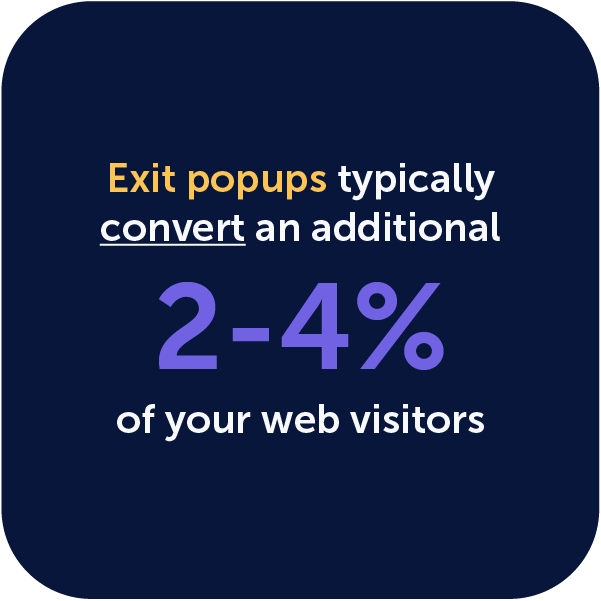
Data source: OptinMonster
8. Increasing Average Order Value (AOV) & Margins
The final part is making sure that whenever they buy something in your store, you get more money.
There are two things that influence it. the first is AOV: the bigger – the more money you get, most likely. The second is margins: the higher – the more money is left in your account, rather than spent on running the same business. Can you do something with your store to increase these two metrics?
Sure, you can:
- Offer a minimum order threshold for free shipping. That encourages customers to buy more. Also, calculate the appropriate threshold for your orders based on how much the shipping will actually cost, and that will depend on where your customers are.
- Offer product bundles. They should cost less than the sum of the prices of individual items. That could be gift bundles, subscriptions, anything. Yes, that’s increasing AOV while decreasing the margin. Bundles can significantly boost sales: in their article, Shopify gives examples of 15-20% increase in AOV after introducing bundles.
- Use margin-based sorting in category pages and on-site search results so that visitors see products with highest margins first by default. But make sure that the products are good and relevant, because good top products can increase the site’s sales. In his Medium post, M.R. Khosravi explores the strategy and compromises you need to make to offer the right products at the top of each category page and search pages.
There are 11 more hacks on maximizing margins and AOV in our eCommerce checklist. Try them out and increase revenue from your business.
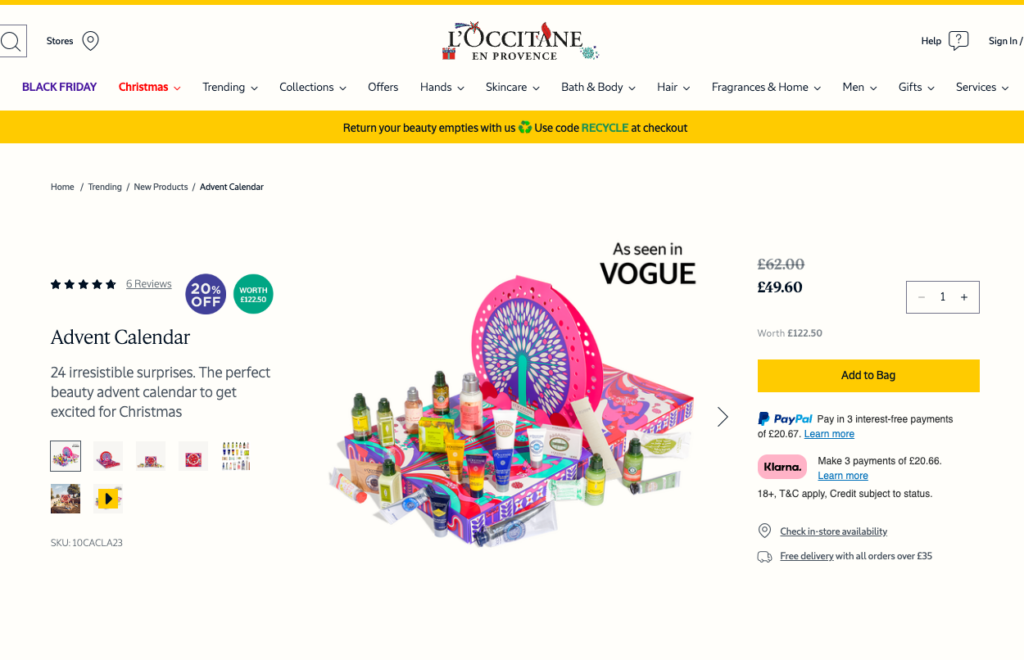
L’Occitane offers an Advent Calendar – a product bundle for Christmas. Source: L’Occitane
How to Use The eCommerce Optimization Checklist
The eCommerce Optimization Checklist is a goldmine when wielded correctly. Here’s the process we recommend for using the checklist:
- Inspect real-life examples: The checklist provides a real-life example for each experiment. Study the examples to fully understand the idea of the experiment and how the optimization can look.
- Comprehend the experiment: Get a picture of how the experiments might look when applied to your eCommerce store.
- Prioritize: Assign priority based on impact, confidence, and ease of implementation. There’s a column for each of these in the checklist, and once you put in the numbers, you get the priority score. The higher it is, the higher is the priority of the experiment. Note that there are some numbers that we’ve already inserted based on our previous experience with eCommerce optimization and the experience that Mouseflow partners had. But the numbers may be different for your case.
- Implement or A/B test: Decided on what to do? Act upon the insights or conduct A/B tests to ascertain the efficacy before a full-scale implementation.
- Retain what works: Adopt the strategies that have proven to foster a positive impact. Mark them in the checklist so that it provides you with a picture of what you have already done and what results you got.
eCommerce optimization is a never-ending journey of continuous refinement. The eCommerce Optimization Checklist is more than just a to-do list; it’s a strategic ally on this journey. Use it to gain more visitors, better cater to their needs and wants, convert them more efficiently, and make them happy returning customers that recommend your store to their peers.
This page was updated in March 2024 to include the latest statistics on cart abandonment.
Download the full checklist
FAQ

In our case, it’s a Google sheet with experiment suggestions, examples, and prioritization. You can copy it and use it for conversion optimization, driving more traffic, and increasing revenue.

CRO in eCommerce is a process of increasing the percentage of website visitors who perform a specific action. You can define conversions as adding something to cart or completing a purchase. Conversion rate is the percentage of website visitors who convert.
Optimizing conversion rate can help you get more customers without increasing acquisition budgets.
It’s worth noting that CRO goes beyond improving your website for more sales. It also includes optimizing ads to attract the right kind of visitors and tweaking your site for better search engine rankings to increase traffic.

Search engine optimization (SEO) is an important part of overall conversion rate optimization efforts. Optimizing your eCommerce website for search engines can help more people discover your store. Don’t mistake it for searchability though. The latter is more about improving your own website’s search engine and the result pages that it generates.
Here’s a short list of tactics to use to optimize your eCommerce for search engines:
- Optimize for the right keywords. Choose relevant keywords your customers are likely to search for. Use tools like Google Keyword Planner or Semrush for keyword ideas and competition analysis.
- Enhance product page experience: Improve your product pages’ content quality, aligning with Google’s EEAT guidelines for better rankings. There are some hacks for that in our checklist.
- Use structured data for rich snippets. Implement structured data markup (think ratings and reviews) to show detailed product information in search results.
- Improve navigation and site structure. Make sure your website is easy to navigate with clear categories, breadcrumb navigation, and clean URLs. We have some more detailed recommendations for that in the checklist.
- Fix broken links and optimize 404 pages. Regularly check and fix broken links to improve customer experience and SEO. Also, use an engaging 404 page to redirect users to relevant parts of your site.
- Boost page speed. Optimize image file sizes, streamline CSS and JavaScript, and implement lazy loading to enhance site speed. Mouseflow can help with Javascript errors a lot.
- Optimize for mobile. Make sure the mobile version of your site is user-friendly. According to Statista, mobile eCommerce (aka m-commerce) was the highest growing sales channel in the US in 2022.
- Start a blog. Create a blog with product reviews to target various keywords related to your products and industry, driving more traffic to your product pages. Google itself recommends this best practice.
- Earn backlinks. Increase backlinks by guest writing, partnering with affiliates, and producing high-quality blog content.
- Use internal linking. Internally link to your products, categories, and blog posts to distribute link equity and improve SEO.
- Avoid duplicate content. Create unique product descriptions instead of copying from other sites. Also, prevent category pages and search result pages from being indexed to avoid duplicate content issues.
However, this is not a full-fledged eCommerce SEO Checklist. Apparently, there are many meanings to “eCommerce optimization”, and one of them is search engine optimization for eCommerce websites. If you were looking for a checklist to follow so that you can improve traffic and rank for the right keywords, Semrush has a good one. In our checklist, we touch on SEO, but only slightly. We are more focused on optimizing for conversions – after all, this is an eCommerce conversion rate optimization checklist.

No, you don’t. The checklist is free, doesn’t require creating an account, and only features a few hacks related to Mouseflow. However, relying on a user behavior analytics tool like Mouseflow can help you quickly find and fix user experience issues and improve your website design, thus increasing conversions and ultimately driving more revenue. Here’s a blog post dedicated to CRO with Mouseflow.
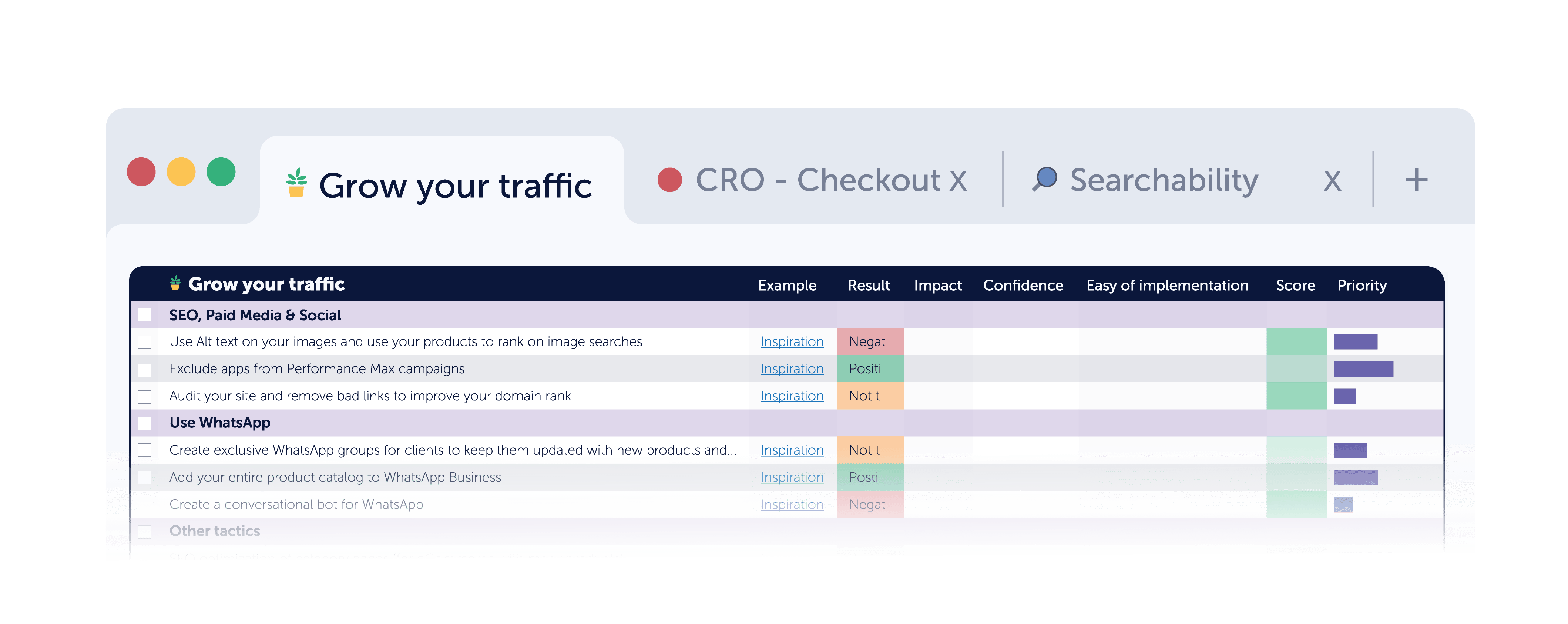

Don’t panic. This is expected especially nowadays where paid channels’ inventory increased cost. Let’s flip the script and use the checklist to improve your operation to improve your cost efficiencies.
It’s time to cross the chasm and install an optimization machine that can work for you and scale your operation and revenue. Use the checklist to justify resources and provide an experimentation roadmap that has been tested and approved by successful businesses.
Customer experience is at the center of any successful business, but you’d be surprised at how many neglect to create a effective, end-to-end strategy that looks at your customers from every angle. Use this checklist to beat your competitors with a best-in-class online experience.